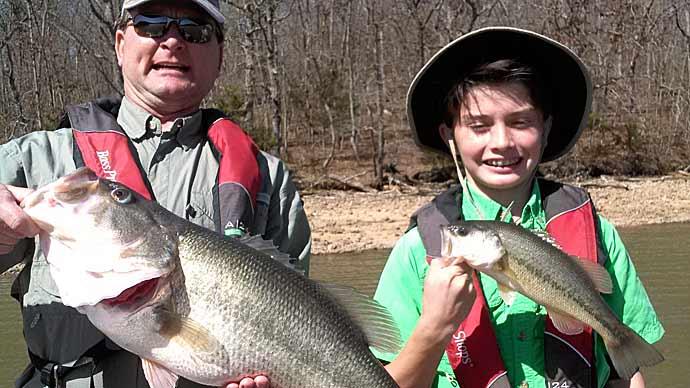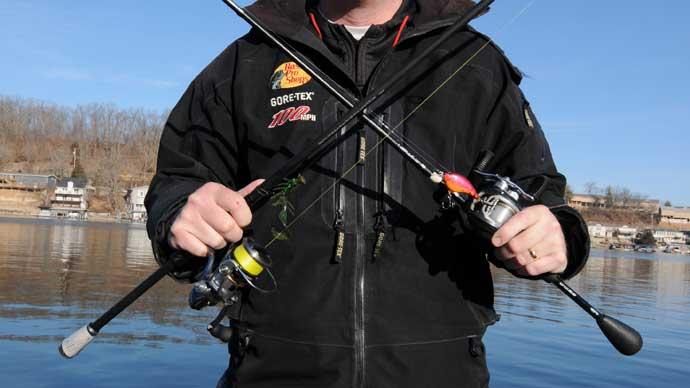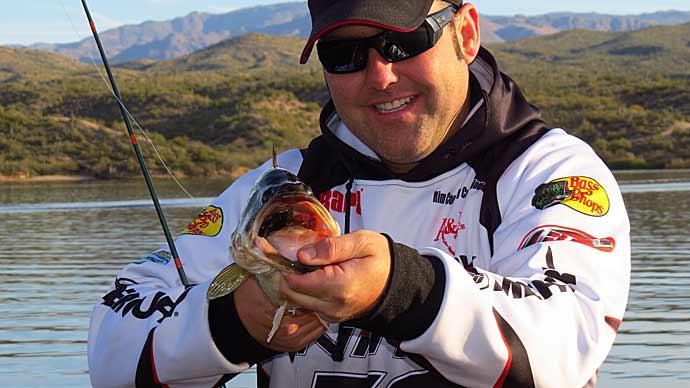
The fastest bass boat, latest technology, and best lures, rods, reels, and lines that money can buy are nice. But they don’t mean a thing if you aren’t around bass. Catching them always starts with finding them. You can take that to the bank.
Bassmaster Elite Series angler Greg Hackney has made a living catching bass. He has won six B.A.S.S. tournaments, including three Elite Series events, fished 16 Bassmaster Classics, and is the 2014 Toyota Bassmaster Angler of the Year. And while those accolades came from what he put on the scale, he had to find those bass first. And that’s rarely a happy accident.
Bass are their most mobile twice a year. They move shallow in fall, following baitfish seeking better water conditions, before retreating to deeper wintering holes. They return to shallow water in spring when they spawn. The prespawn season is busy for bass. They’re aggressive, eating more and more as the water temperature rises.
Finding prespawn bass requires timing and location. You’ll miss out on some of the year’s best fishing if you get either wrong. Hackney’s prespawn tips will put you on the right side of things.
Find a starting point
Many "rules" have been written about bass fishing. For example, the books say bass, whether headed to shallow or deep water, use structure and cover as a type of highway. It could be a long point, creek channel, or flooded tree line. But Hackney cautions not to believe everything that you read.
Hackney said migration routes are more important early in the prespawn season. But he starts his approach by skipping ahead. "The first thing you look for is where you think they will spawn, then the stuff out in front of it," he said. "Typically, the first ones move up on the closest structure to a ditch or deeper water.” Then, they continue moving shallower, using cover and structure along the way.
Image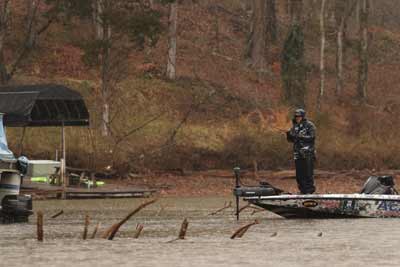
According to Bassmaster Elite Series angler Greg Hackney, water temperature, amount of daylight, and other variables play roles in bass movements during the prespawn season. High water always makes shallow cover inviting to anglers, but bass won’t be there if it’s too early in the season. Photo courtesy of B.A.S.S. / Seigo Saito Bass move faster once the water temperature warms into the high 50s or low 60s. They hunt prime spawning cover — protected flats, hard bottoms, hardcover — and don't care how they get there. "[Migration routes are] irrelevant then," Hackney said. “They do what they want to do. It has nothing to do with a channel or structure. Once the spawn is cranking, you can go across a flat 3 feet deep for a half-mile, and they're in the bushes in the back of it."
How long they remain on any prespawn spot depends on several factors. Some can change fast. For example, the sun was out between practice and competition days at the 2022 Bassmaster Classic, and the air temperature warmed into the 80s. “I would say 95% of the fish are prespawn,” Hackney said while waiting to begin competition on Lake Harwell, an impoundment shared by South Carolina and Georgia. “Now that can change overnight with the weather we're having." Predictions of sight-fishing for spawners by the end of the three-day contest floated around the boatyard.
Warming water temperature lures prespawn bass to the bank. It’s a variable historically used to locate bass in prespawn and spawn. But it’s inconsistent. Lake Hartwell, for example, is enormous — about 56,000 acres. He said groups of its bass as close as 20 miles apart could do completely different things because of the local water conditions.
Hackney said the amount of daylight increases as spring progresses and is a more powerful and consistent trigger for prespawn bass. It overrides water temperature cues, which can be delayed by elevation and winters that are longer and colder than average. "I've seen them in frigid water because it was the right time of the year," he said. “And I’ve seen it get too warm too early, and they don’t come.”
Hackney uses a particular visual clue to determine the end of the prespawn season. “Anywhere we go, if I see green buds on the trees, you can believe they’re spawning,” he said. “Everything is all together. Mother nature has a way of taking care of herself. They don’t rush out and do what they’re not supposed to do. That’s what keeps them going every year.”
Keep pace
Few weather conditions send a more significant chill down a bass angler’s spine than springtime cold fronts. Their cold northerly wind seems to arrive just as the water temperature is warming and bass are munching, shutting down the bite. Hackney said the early ones are the worst, forcing bass just beginning their prespawn migration to give up. “You get some early ones that come up, and it seems like it doesn’t take a lot to knock them in the head,” he said.
But as the prespawn season progresses, bass are less affected by cold fronts. “Once you get later on, typically what they do is just lockdown right where they are,” he said. “They may quit the process, but they never leave. They sit there. When it gets to a certain point, they know [the conditions will] come right back.”
During late prespawn, stable summer weather begins to arrive. “If you think about it, the later in the spring it gets, the shorter your front periods are,” Hackney said. “You don’t have a week of cold weather then — you have two days." That allows bass to continue doing what they need to.
Bass don't move through prespawn en masse. Instead, they travel in waves that roll in response to local conditions. Late in prespawn, bass split into two groups based on gender. Hackney said male bass, who search for suitable nesting spots, are the first to go to the bank. Females congregate in slightly deeper water, waiting for conditions to optimize. He said the latter are easy to identify because many develop black spots on their sides, a manifestation of stress from egg production.
Choose a lure
The best lures for prespawn bass depend on the fishery. But Hackney can point to a few that produce consistently across the bass range. They include jerkbaits, square-bill, lipless crankbaits, and vibrating jigs. Each generates reaction strikes by tapping into the aggressive temperament of prespawn bass. And they make it easy for anglers to cover water, searching for bass.
Even though water temperature can be relatively cold during prespawn, Hackney resists the urge to try slower bottom-bouncing lures such as jigs. Instead, he sees their productivity increase closer to the actual spawn.
Make adjustments
The best bass-fishing information points you in the right direction. And once there, you need to assess the current conditions and make appropriate adjustments. It’s no different during prespawn. Lakes, rivers, reservoirs — the water in question doesn’t matter. Hackney said all vary from year to year. So a spot where you caught them last year may be worthless because it’s 10 feet deeper or high and dry, and bass aren’t interested in either.
Hackney said prespawn bass are easiest to target during low water levels. It forces more bass through fewer spots. For example, a bridge at the mouth of a creek arm can be a prime spot. Bass have to go under it to reach shallow water on the other side. So, you only have to look there, not here or anywhere.
Image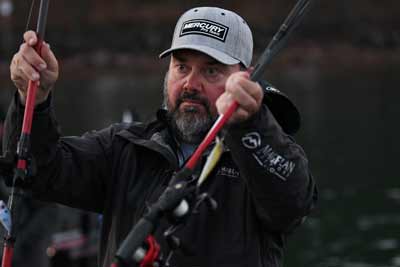
Bassmaster Elite Series angler Greg Hackney leans on moving lures to catch prespawn bass. Bottom-bouncing baits, such as jigs, become more productive as the actual spawn nears. Photo courtesy of B.A.S.S. /Chris Brown High water gives prespawn bass more places to swim. But it can make anglers fish too shallow too soon. Prespawn bass won’t use it if daylight and other conditions lag. “It always tends for us to rush it,” Hackney said. “Bass still do what they’re supposed to. But when the water gets big, human nature is they went with the water. But they don’t go until it’s time, regardless.”
While conditions cause variations in prespawn movements from day to day, there is consistency from year to year. "I don't care where you fish. Bass have a certain cycle,” Hackney said. “A fish is a fish.” Take the waters around his Louisiana home, most of which are natural and shallow, as a prime example. Instead of migrating between depth changes, they move between different amounts of current. They spend most of the year in spots awash with current, where they find the best water conditions, especially when it comes to dissolved oxygen during super-hot summer. But during winter, they retreat to slack-water sports, where they remain to spawn in spring. They return to the current during the post-spawn season.
Experience is hard to beat when it comes to deciphering bass cycles. "Whether it's a bad or good one, you learn from those," Hackney said. That gives you past experiences to match to similar current situations. “No matter where I go, something reminds me of something,” he said.
Experience is essential when fishing is tough. Hackney faced this situation at Three Rivers in Pittsburgh, competing in the 2005 Bassmaster Classic. He returned for the 2009 Forrest Wood Cup, which he won. He said his biggest mistake at the Classic was trying to catch two or three 2- to 3-pounders every day. They weren't enough to outpace anglers targeting the more numerous small bass. So, he followed their lead when he returned for the Cup, maximizing the number of 12-inch bites as possible and capitalizing on bigger bites. It paid off.


